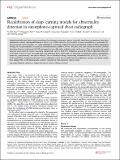Recalibration of deep learning models for abnormality detection in smartphone-captured chest radiograph
Author(s)
Kuo, Po-Chih; Pollard, Tom Joseph; Johnson, Alistair Edward William; Celi, Leo Anthony G.
DownloadPublished version (1.141Mb)
Publisher with Creative Commons License
Publisher with Creative Commons License
Creative Commons Attribution
Terms of use
Metadata
Show full item recordAbstract
Image-based teleconsultation using smartphones has become increasingly popular. In parallel, deep learning algorithms have been developed to detect radiological findings in chest X-rays (CXRs). However, the feasibility of using smartphones to automate this process has yet to be evaluated. This study developed a recalibration method to build deep learning models to detect radiological findings on CXR photographs. Two publicly available databases (MIMIC-CXR and CheXpert) were used to build the models, and four derivative datasets containing 6453 CXR photographs were collected to evaluate model performance. After recalibration, the model achieved areas under the receiver operating characteristic curve of 0.80 (95% confidence interval: 0.78–0.82), 0.88 (0.86–0.90), 0.81 (0.79–0.84), 0.79 (0.77–0.81), 0.84 (0.80–0.88), and 0.90 (0.88–0.92), respectively, for detecting cardiomegaly, edema, consolidation, atelectasis, pneumothorax, and pleural effusion. The recalibration strategy, respectively, recovered 84.9%, 83.5%, 53.2%, 57.8%, 69.9%, and 83.0% of performance losses of the uncalibrated model. We conclude that the recalibration method can transfer models from digital CXRs to CXR photographs, which is expected to help physicians’ clinical works.
Date issued
2021-02Department
Massachusetts Institute of Technology. Institute for Medical Engineering & ScienceJournal
npj Digital Medicine
Publisher
Nature Publishing Group
Citation
Kuo, Po-Chih et al. “Recalibration of deep learning models for abnormality detection in smartphone-captured chest radiograph.” npj Digital Medicine, 4, 1 (February 2021): 25 © 2021 The Author(s)
Version: Final published version
ISSN
2398-6352